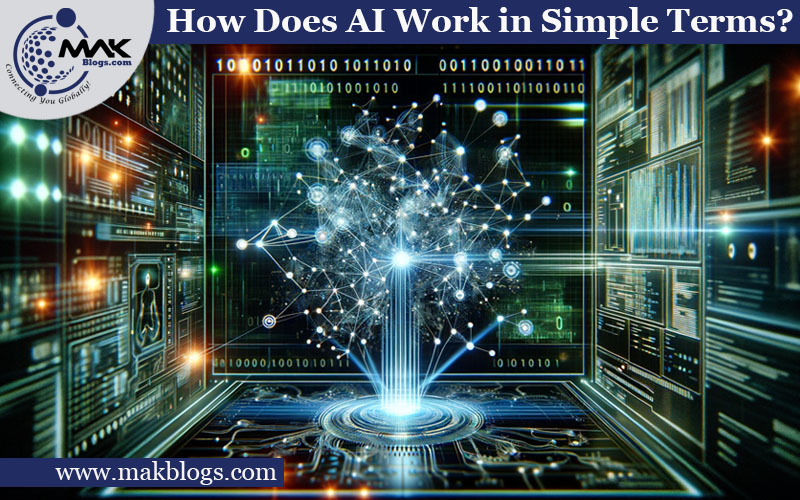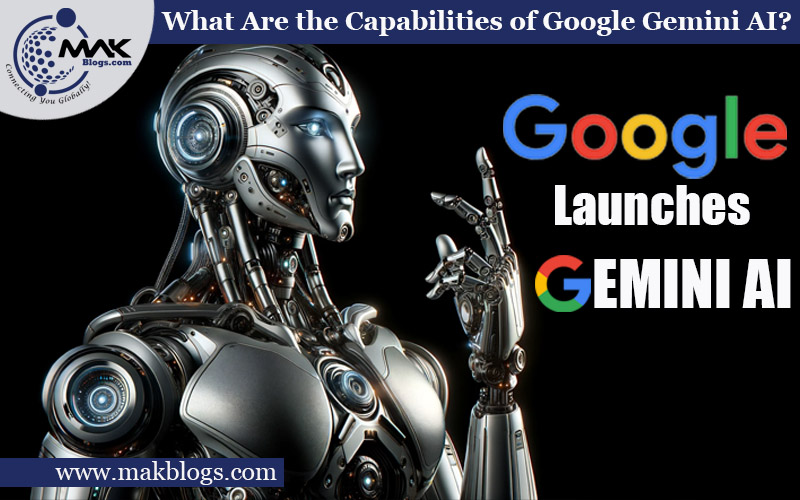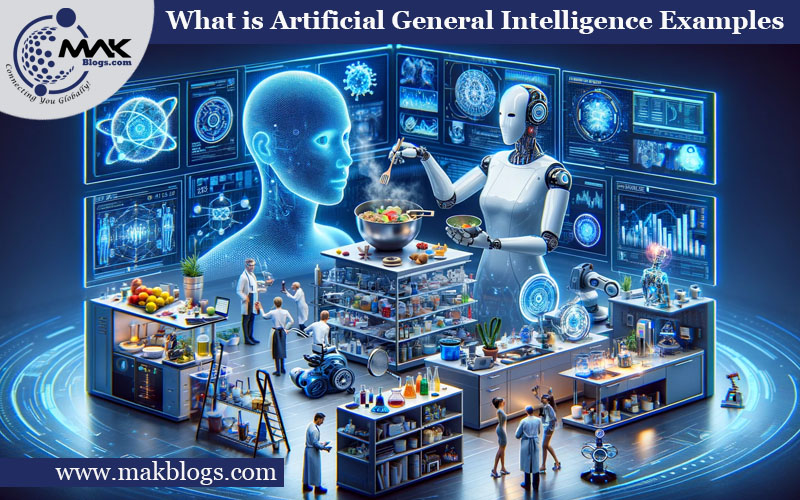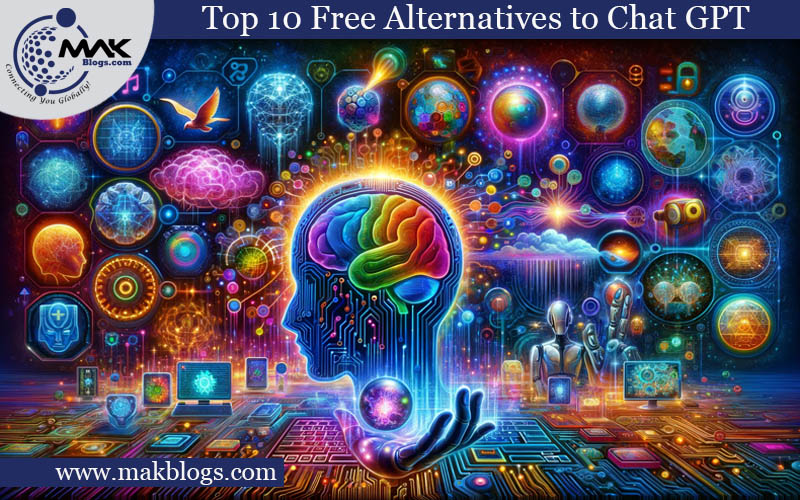Table of Contents
ToggleQuick Overview of “How Does AI Work in Simple Terms?”
How does AI work in simple terms? It combines data, algorithms, and potent computing power to replicate human Intelligence. AI encompasses Narrow AI, specializing in specific tasks, and General AI, striving for human-like abilities. Machine learning (ML), the foundation of AI, instructs machines to acquire knowledge from data. ML comes in various forms, such as supervised and unsupervised Learning, while Deep Learning and Natural Language Processing (NLP) further expand AI’s capabilities. Real-world applications range from image recognition to healthcare diagnostics and autonomous vehicles. The future promises enhanced healthcare, smarter cities, and AI-driven content creation. Indeed, for more details, please read the full article.
How does AI work in simple terms?
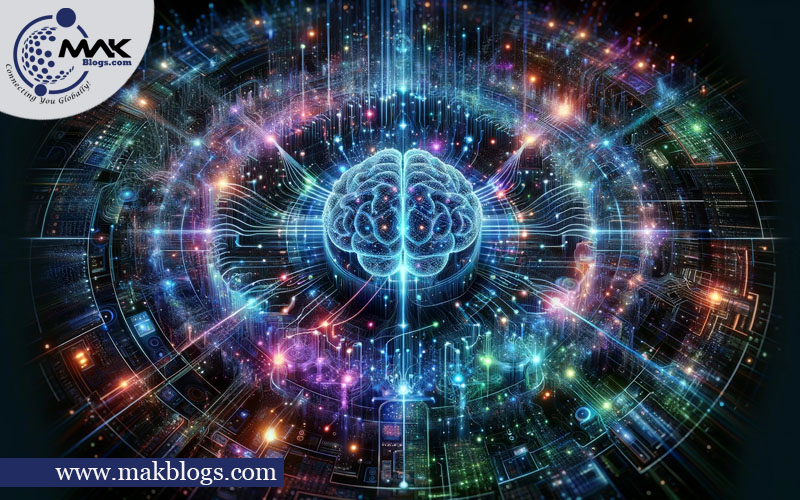
Introduction
Artificial Intelligence (AI) has recently become an intriguing subject and with good reason. Its transformative potential across various industries and its potential impact on our daily lives is nothing short of remarkable. However, for many, AI remains a complex and enigmatic concept. To provide a clear and concise explanation of how AI functions, this article will unravel its complexities. So, if you’ve ever pondered the question, “How does AI work in simple terms?” you’ve come to the right place.
Understanding the Basics of AI
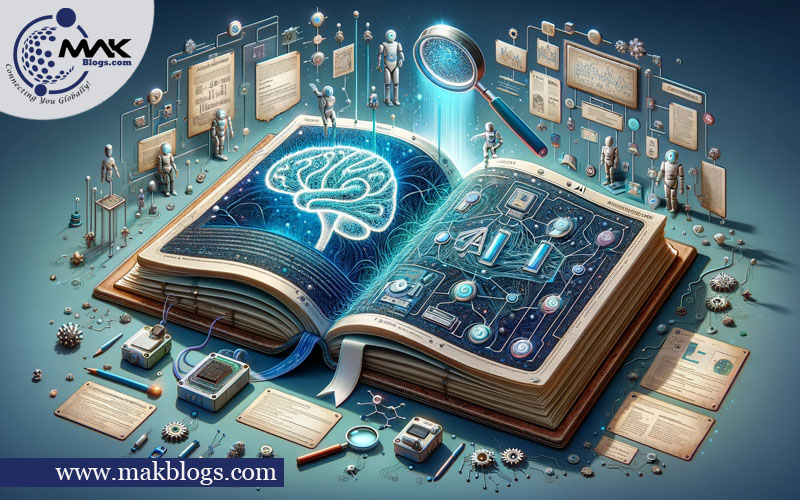
Before diving into the intricacies of AI, let’s start with the fundamentals.
What is AI?
At its core, AI is the simulation of human Intelligence in machines programmed to think, learn, and solve problems like humans. This simulation of human Intelligence is achieved through a combination of data, algorithms, and computing power.
The Role of Data
Data is the lifeblood of AI. Machines need vast amounts of data to learn and make decisions. This data can be anything from text and images to sensor readings. It serves as the foundation upon which AI systems are built.
Algorithms: The Brain of AI
Regarding, how does AI work in simple terms? Algorithms are the sets of instructions that AI systems follow to process and analyze data. Depending on the task at hand, these algorithms can range from simple to highly complex. These components empower AI to execute designated operations, including pattern recognition, prediction generation, and problem resolution.
Computing Power
AI systems require significant computing power to process enormous amounts of data and execute complex algorithms. This is where modern high-performance computers and specialized hardware like GPUs (Graphics Processing Units) come into play.
Types of Artificial Intelligence (AI)
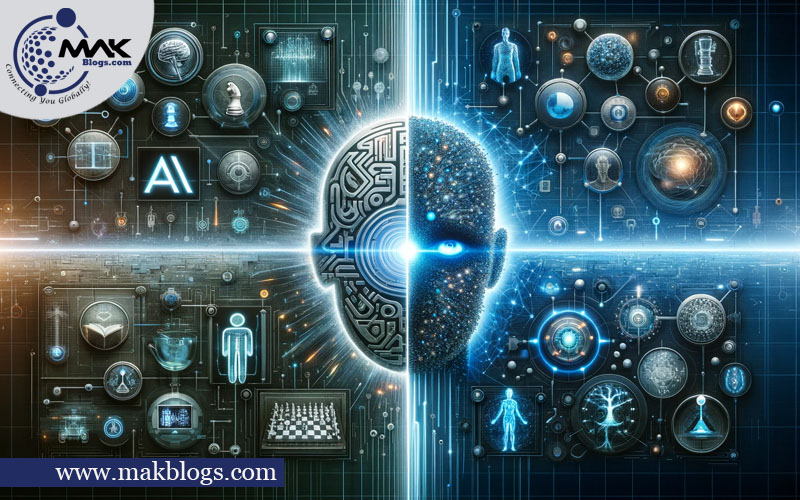
Narrow artificial Intelligence, also known as weak AI, and general artificial Intelligence, also known as strong AI, are the two primary forms of machine learning.
Let’s explore these categories in greater detail
Narrow AI (Weak AI)
In the realm of how does AI work in simple terms? Narrow AI, or Weak AI, is designed for specific tasks and excels in performing predefined functions. It operates within a limited domain and cannot generalize beyond its programmed capabilities.
Here are critical points about Narrow AI:
- Task-Specific: Narrow AI is task-specific and specialized to excel in a particular function.
- Well-defined: It operates under well-defined parameters and limitations.
- Efficiency: These AI systems are highly efficient and accurate within their designated tasks.
- Examples: In the context of how does AI work in simple terms? Examples include virtual personal assistants (e.g., Siri, Alexa), which can answer questions, set reminders, and control smart devices.
- Chatbots: Chatbots are used in customer service to respond to common queries.
- OCR Software: For optical character recognition (OCR) that transforms handwritten or printed text into digital format.
- Speech Recognition: Speech recognition systems that transcribe spoken language into text.
- Email Filtering: Email filtering systems that automatically categorize emails as spam or essential.
- Recommendation Engines: Recommendation engines on streaming platforms like Netflix or YouTube that suggest content based on user preferences.
- Language Translation: Language translation services that convert text or speech from one language to another.
- Facial Recognition: Facial recognition systems are used for unlocking smartphones or verifying identities.
- Autonomous Drones: Autonomous drones programmed for specific tasks like aerial photography or surveillance.
- Traffic Management: Traffic management systems that optimize traffic flow in real-time.
- Medical Diagnosis: While discussing how does AI work in simple terms? Medical diagnosis tools specialize in identifying specific diseases or conditions.
- Fraud Detection: Fraud detection algorithms that monitor financial transactions for suspicious activity.
General AI (Strong AI)
General artificial Intelligence, often known as Strong AI or AGI (Artificial General Intelligence), is a more sophisticated kind of artificial Intelligence that possesses cognitive abilities and Intelligence comparable to those of humans. While General AI is still largely theoretical and hasn’t been fully realized, it holds the potential for wide-ranging applications.
Here are critical points about General AI:
- Human-Like Intelligence: General AI can learn and adapt to many tasks and has human-like Intelligence.
- Versatility: It can transfer knowledge and skills from one domain to another, demonstrating versatility.
- Understanding Context: General AI can understand context and reason and apply knowledge across diverse scenarios.
- No Boundaries: Unlike Narrow AI, it does not operate within constrained boundaries but can tackle unfamiliar challenges.
- Creative Problem-Solving: In the realm of how does AI work in simple terms? General AI can engage in creative problem-solving and handle novel situations.
- Diverse Tasks: It has the potential to perform tasks across multiple domains, such as translating languages, playing musical instruments, and scientific research.
- Advanced Language Comprehension: General AI can engage in natural and meaningful conversations with humans, demonstrating advanced language comprehension.
- Emotional Intelligence: It can exhibit emotions, empathy, and social Intelligence, making it capable of meaningful interactions with people.
- Ethical Considerations: The development of General AI raises ethical questions related to consciousness, rights, and responsibilities.
- Complexity: Achieving General AI requires a deep understanding of human cognition and a profound level of computational complexity.
- Research: Research in the field of General AI involves simulating human thought processes and decision-making.
- Self-Improvement: AGI systems would be capable of self-improvement, which could lead to rapid advancements.
- Applications: Potential applications of General AI include automating complex medical, research, and education tasks.
- Industry Revolution: Regarding how does AI work in simple terms? It could revolutionize industries by taking on roles currently performed by humans, such as creative arts, scientific discovery, and strategic decision-making.
- Grand Challenge: Achieving General AI remains a grand challenge in AI, and its realization would be a significant milestone in human history.
Machine Learning: The Heart of AI

Now, let’s delve even deeper into one of the most crucial aspects of AI: Machine Learning (ML). This elaboration offers a comprehensive synopsis of Machine Learning, encompassing its diverse classifications and practical implementations.
What is Machine Learning?
An area of artificial Intelligence, machine learning develops methods to help machines learn from data and make predictions or judgments. It’s akin to teaching a computer to enhance its task performance through experience.
Here’s a more comprehensive explanation:
- In the context of How does AI work in simple terms? Machine Learning encompasses various techniques, including statistical models, neural networks, and decision trees.
- It’s driven by the idea that machines can learn patterns from data, generalize from what they’ve learned, and apply that knowledge to new, unseen data.
- Machine Learning is divided into supervised, unsupervised, and reinforcement Learning, each suited for specific tasks and scenarios.
How Machine Learning Works
Let’s break down the intricate process of Machine Learning in more detail:
- Data Collection: Relevant data is meticulously collected, cleaned, and prepared for training. This process involves sourcing and preprocessing vast datasets to ensure quality and suitability for the task at hand.
- Training: The machine learning model is exposed to the prepared data, learning patterns, correlations, and relationships. This training phase can vary in complexity and duration, depending on the problem’s intricacy.
- Testing and Validation: After training, the model’s performance is rigorously evaluated using new, unseen data. This evaluation involves various metrics to assess the model’s accuracy, precision, recall, and other factors.
- Deployment: While discussing how does AI work in simple terms? Once the model proves its efficacy and reliability through testing and validation, it is put into practical use for real-world predictions, decision-making, or automation of tasks.
Supervised Learning
With labelled data, supervised Learning is one of the most prevalent types of machine learning.
Here’s a deeper look at supervised Learning:
- Labelled Data: In supervised Learning, the algorithm is trained on labelled data, where each input data point is associated with the correct output or target value.
- Examples: Examples of supervised learning tasks include image classification (labelling images as cats or dogs), sentiment analysis (classifying text as positive or negative), and predictive modelling (forecasting stock prices based on historical data).
Unsupervised Learning
In the realm of how does AI work in simple terms? Unsupervised Learning, in contrast, deals with unlabeled data and aims to discover patterns or structures within the data.
Here’s an in-depth view:
- Clustering: Unsupervised Learning often involves clustering algorithms that combine similar data points. One use of clustering is segmenting customers based on their purchasing habits.
Deep Learning
Because of its outstanding effectiveness across various domains, deep Learning—a subset of machine learning—has garnered much attention.
Here’s more information on deep Learning:
- Artificial Neural Networks: Neural networks, which are deep learning models, are composed of numerous strata of interconnected nodes. The human brain’s neural architecture inspires this structure.
- Applications: Deep Learning excels in image and speech recognition, natural language processing, and autonomous driving.
Natural Language Processing (NLP)
Regarding how does AI work in simple terms? NLP, an intriguing domain within AI, is dedicated to developing technologies capable of comprehending, interpreting, and producing human language.
Here’s a deeper dive into NLP:
- Text Analysis: NLP powers a wide range of applications, including chatbots that engage in natural language conversations, language translation services, and sentiment analysis tools that assess emotions in text.
AI in Action
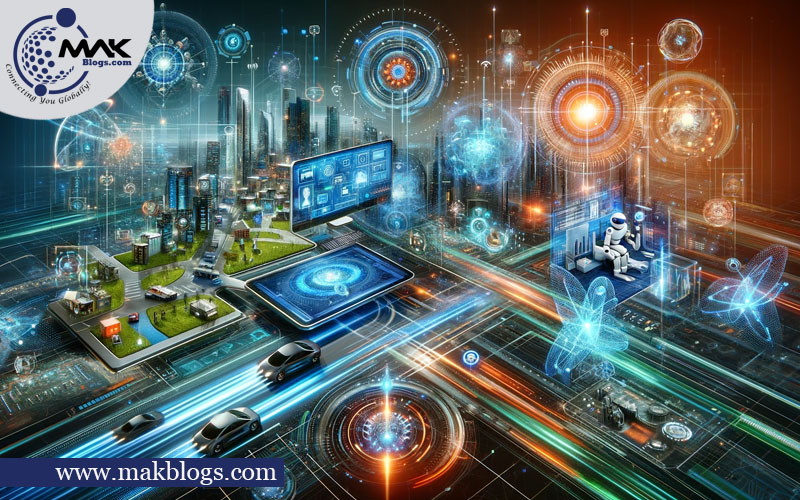
To truly appreciate how AI operates in the real world, let’s delve deeper into several compelling and detailed examples of its practical applications:
1. Image Recognition
AI-powered image recognition systems represent a remarkable advancement in computer vision technology. These systems utilize complex algorithms and neural networks to analyze and interpret visual data from various sources, including cameras and sensors.
Here’s a more detailed look at image recognition:
- Object Identification: In the context of How does AI work in simple terms? AI algorithms can identify objects within images and distinguish between different objects. For example, in self-driving cars, image recognition enables the vehicle to detect pedestrians, road signs, other vehicles, and even specific objects like bicycles or traffic cones.
- Facial Recognition: Besides social media platforms, facial recognition technology has been extensively implemented in security systems and smartphone unlocking. It analyzes facial features to identify and authenticate individuals.
2. Recommendation Systems
While discussing How does AI work in simple terms? AI-driven recommendation systems have transformed how we discover online content, products, and services. They leverage complex algorithms to understand user preferences and provide tailored suggestions.
Here’s a closer look at recommendation systems:
- Personalization: These systems analyze your past behaviour, such as what you’ve watched, read, purchased, or liked, to create personalized recommendations. They use collaborative and content-based filtering techniques to match your preferences with relevant content.
- For example, using recommendation algorithms, Netflix suggests movies and television programs to users based on their ratings and viewing history. Similarly, Amazon employs AI-driven recommendations to suggest products based on your browsing and purchasing behaviour.
3. Healthcare Diagnostics
In the realm of How does AI work in simple terms? AI has made significant strides in healthcare, particularly in diagnostics. A growing number of medical practitioners are placing their trust in AI-driven instruments to assist in the analysis of medical images and enhance the precision of diagnoses:
- Medical Imaging: AI algorithms can analyze medical images, such as X-rays, MRIs, and CT scans, to assist radiologists in detecting and diagnosing diseases and anomalies. For example, in the case of lung cancer, AI can help identify early-stage tumours that human observers may miss.
- Pathology: AI is also used to analyze pathology slides and aid pathologists in diagnosing diseases like cancer more efficiently. Machine learning algorithms can identify abnormal cells or tissue patterns with great accuracy.
- Drug Discovery: In drug discovery, AI analyses vast datasets and predicts potential drug candidates, significantly accelerating the development process.
4. Autonomous Vehicles
Regarding How does AI work in simple terms? Self-driving cars, a prime example of AI in action, rely on an array of sensors, cameras, and AI algorithms to navigate, make decisions, and ensure the safety of passengers and pedestrians:
- Sensors and Perception: Autonomous vehicles use LiDAR, radar, and cameras to gather real-time data about their surroundings. AI algorithms process this data to detect and recognize road objects, lanes, and obstacles.
- Decision-Making: AI systems in self-driving cars make complex real-time decisions, such as when to accelerate, brake, change lanes, or make turns. These decisions are based on sensor data, pre-trained models, and constant analysis of the driving environment.
- Safety: AI plays a crucial role in ensuring the safety of autonomous vehicles by detecting potential hazards, predicting collision risks, and taking preventive actions, such as emergency braking.
The Future of AI
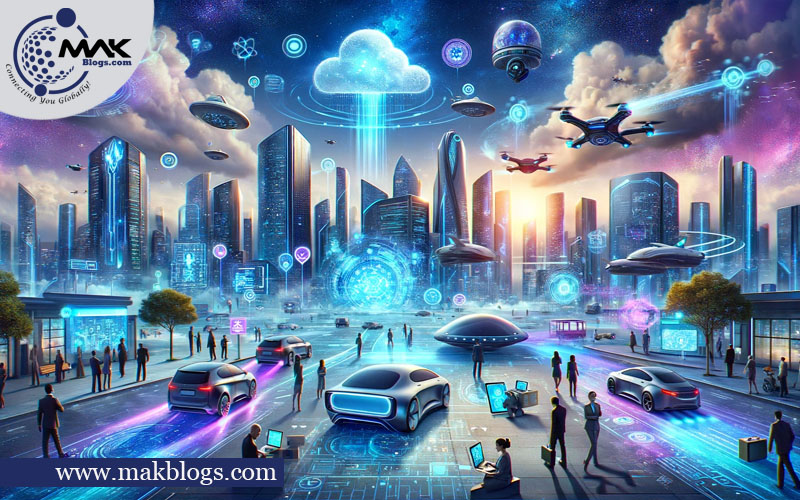
Regarding How does AI work in simple terms? The continuous evolution and expansion of AI’s capabilities render its potential applications practically boundless.
Here are ten detailed scenarios that provide insights into the future of AI and how it will continue to shape our lives:
- Enhanced Healthcare: AI-driven diagnostic tools will become more sophisticated, enabling earlier and more accurate disease detection. Robotic surgery systems will offer precision and efficiency in the operating room.
- Autonomous Transportation: Fully autonomous vehicles will become commonplace, revolutionizing transportation by reducing accidents, congestion, and the need for human drivers.
- Intelligent Cities: AI will play a central role in creating more innovative and efficient cities, optimizing traffic flow, managing energy consumption, and enhancing public safety.
- Advanced Cybersecurity: While discussing How does AI work in simple terms? AI-driven cybersecurity solutions will be essential in identifying and mitigating cyber threats in real time, safeguarding businesses and individuals.
- Environmental Impact: AI will be crucial in analyzing environmental data, predicting natural disasters, and finding innovative solutions for climate change and resource management.
- Content Creation: AI-generated content, including art, music, and literature, will become more refined, potentially blurring the lines between human and machine creativity.
- Enhanced Customer Experiences: AI-driven chatbots and virtual assistants will provide highly personalized customer support, anticipating user needs and offering tailored solutions.
- Workplace Automation: In the realm of How does AI work in simple terms? AI and robotics will automate routine tasks, allowing human workers to focus on creative and strategic aspects of their jobs, ultimately boosting productivity and efficiency.
References
Google AI: Google’s AI research and developments provide valuable insights into artificial Intelligence.
Conclusion
In conclusion, how does AI work in simple terms? It can be distilled into the harmonious integration of data, algorithms, and potent computing power, enabling machines to emulate human Intelligence. Within this framework, Machine Learning, a vital facet of AI, facilitates the learning process. AI’s far-reaching impact spans across industries and holds limitless potential for the future. By grasping the basic mechanics of AI, we gain a clearer understanding of its pivotal role in our ever-evolving world, where it continues to reshape the way we live, work, and interact with technology.
FAQs Related to “How Does AI Work in Simple Terms?”
The easiest way to explain AI is to think of it as teaching computers to be innovative and make decisions, just like we do. Read more in the above post titled “How Does AI Work in Simple Terms?”
AI works by using computers to process lots of information, learn from it, and then use that knowledge to do tasks or solve problems. Read more in the above post titled “How Does AI Work in Simple Terms?”
For beginners, AI is like having a computer friend who learns from information and can help with different things, like answering questions or playing games. Read more in the above post titled “How Does AI Work in Simple Terms?”
To explain AI to a child, you can say it’s like having a special robot friend that learns from talking to people and books, and then it can help with all sorts of fun and helpful things. Read more in the above post titled “How Does AI Work in Simple Terms?”

